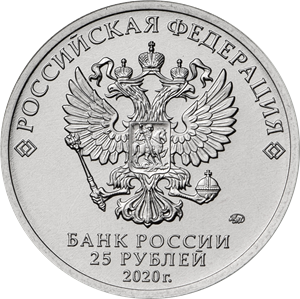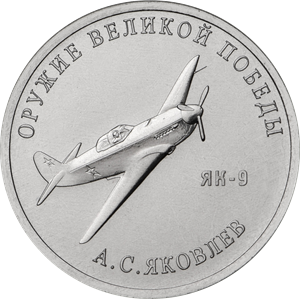Weapons Designer Alexander Yakovlev
Obverse
in the centre there is a relief image of the National Coat of Arms of the Russian Federation and over it a semicircular inscription along the rim: "РОССИЙСКАЯ ФЕДЕРАЦИЯ" (RUSSIAN FEDERATION) framed by doubled rhombuses on both sides, under the emblem, in three lines, there is an inscription: "БАНК РОССИИ" (BANK OF RUSSIA), the coin’s par value "25 РУБЛЕЙ" (25 RUBLES), and the year of issue "2020 г." (2020), and on the right there is a mint trade mark.
Reverse
a relief image of the Yak-9 fighter aircraft and the inscription‘ЯК-9’ (YAK-9) on the right; along the rim there are the inscriptions ‘ОРУЖИЕ ВЕЛИКОЙ ПОБЕДЫ’ (WEAPONS OF THE GREAT VICTORY) at the top and ‘А.С. ЯКОВЛЕВ’ (ALEXANDER YAKOVLEV) at the bottom.
Authors
Designers: E.V. Kramskaya (obverse), O.G. Shepel (reverse).
Sculptors: A.A. Dolgopolova (obverse), computer simulation (reverse).
Mint: Moscow Mint (ММД).
Edge: 180 corrugations.
Discover more
Alexander Sergeyevich Yakovlev (1906–1989) was a Soviet aircraft designer known for creating the Yak fighter family, including the Yak-9, the most mass-produced Soviet fighter aircraft during the Great Patriotic War, which was first deployed in 1942.
The Yak-9 was based on the Yak-7 fighter aircraft, but boasted better flight performance and technical specifications. The experience in producing and deploying previous Yak models, as well as the ability to use aluminium in construction, which the Soviet aircraft industry had finally gained by the middle of the war, allowed a substantial decrease in the craft’s weight, in addition to the improvement of a number of features, such as speed, rate of climb, and ease of manoeuvring, without sacrificing the resilience and intuitive controls that were the hallmark of all Yakovlev fighters. The Yak-9’s improved combat efficiency allowed it to successfully withstand the onslaught of German aircraft until the very end of the war.
The fighter was used to provide cover for advancing ground troops, as well as for attack aircraft and bombers. Its design was simple and versatile, making it possible to not only launch mass production at very short notice, but also create over a dozen further modifications, geared for the most diverse of tasks.


